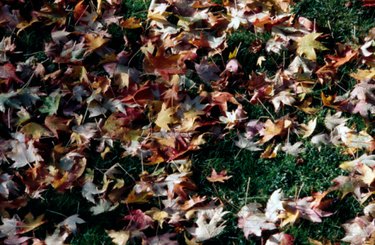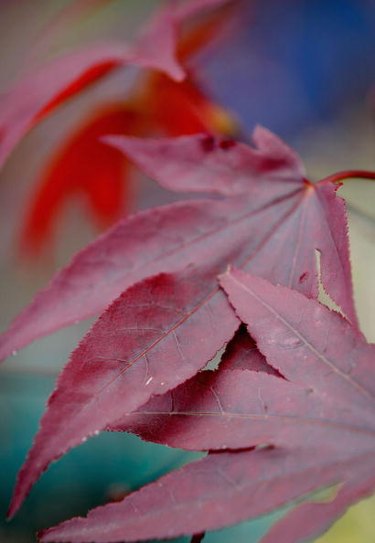
Maples are often associated with having beautiful red, orange and yellow fall color. Their are many varieties that offer color during the growing season as well. Red-leaved maples offer a great contrast in the landscape, and are often used in designs to help bring out the color of surrounding plants. This coloration has a few requirements for it maintain that deep-purple color through the fall.
Different Species of Red-Leaved Maples
Video of the Day

There are many varieties of maples that offer this beautiful summer color. The most common are Japanese maples and Norway maples. Several species of Japanese maples offer cultivars with red foliage: Acer palmatum (the largest group), Acer dissectum (lace leaf) and Acer japonicum (fullmoon maple). Bloodgood, Red Dragon and Crimson Queen are common varieties of Japanese maple. Acer platanoides "Crimson King" is a widely available red-leaved Norway maple that achieves 30 to 40 feet in height and is slow growing, at 5 to 6 inches per year.
Video of the Day
What Gives the Leaves Their Color
Red-leaved plants get their color from a pigment called anthocyanin. Anthocyanin is often displayed in the fall as chlorophyll (the pigment responsible for the color green) breaks down. Anthocyanin absorbs blue-green wavelengths of color, and reflects red. This gives fruit, flowers and leaves their red color. Anthocyanin is water-soluble and is found in the vacuole of the cell, a water-holding structure.
Why They Turn Green
Sun availability and temperature play a key role in the retention of red foliage color throughout the growing season. Trees grown in full sun will display a more vivid, darker color than those planted in partial to full shade. This can be tricky in the case of Japanese maples that need protection from hot, scorching sun to prevent the leaves from drying out along the margins, particularly in the lace-leaf varieties. In large Norway specimens planted in full sun, you will often see the inner leaves a purple-green due to the lack of sun penetration into the inner canopy. Cooler temperatures below 70 degrees F also promote color retention.
How to Maintain the Color
To maintain long-term care of the foliage, initial site selection is key. In the case of Japanese maples, choose a location with morning sun and afternoon shade. If you live in a cooler, northern climate, you may be able to plant in full sun, given adequate moisture is available. Norway maples should be planted in full sun. When selecting a site, look at the surrounding plants and think about how large they will become in 10 years. Shade from competing plants will turn your red maples green. In the case of mature specimens, pruning of surrounding shade plants will allow the needed sunlight to reach your plants. If this is not possible, transplanting your specimen to a different location may be the only option.